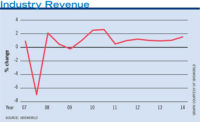According to the Association of Workers’ Compensation Boards of Canada, there were more than 4,000 reported incidents of workplace violence against Canadian nurses between 2008 and 2013, and still, sources in the industry believe that these types of incidents are woefully underreported.
“Violence is by far the biggest issue in healthcare,” says Jeff Young, CHPA, executive director, Lower Mainland Integrated Protection Services at Fraser Health, Provident Health Care, Provincial Health Services Authority and Vancouver Coastal Health, based in Surrey, B.C.
The issue is complex, with many possible contributing factors, industry professionals say, including rising drug problems, decades long deinstitutionalization of mental health care, an aging population, and rise of patients with dementia and Alzheimer’s, as well as cultural shifts and different reporting protocols than in the past.
“When I first started in this industry in the ’80s, violence wasn’t an issue,” recalls Martin Green, CHPA, manager, security, telecommunications and emergency preparedness for Baycrest Health Sciences in Toronto. He says that while violence is a problem in emergency departments, surgical waiting rooms, maternity wards and other traditional hospital settings, there is also workplace violence in senior living and other healthcare facilities — just a different kind.
“We specialize in Alzheimer’s and dementia patients and they might not understand that what they are doing is aggressive or violent. Most of the time they don’t usually hurt someone and they can be a bit frail. You also have family members and visitors coming in and out and they might be inappropriate. When it comes to family dynamics and care and control over a parent, issues can arise. There are so many different dynamics in these settings and the fact that it’s an issue now is quite alarming,” Green says.
As demonstrated from the IAHSS Foundation’s 2016 Healthcare Crime Survey, the majority of violence in healthcare settings is directed at employees or staff by customers, patients or visitors. Focusing on solutions to prevent, mitigate and respond to incidents can help healthcare professionals complete their first priority of delivering quality healthcare to patients.
“This industry is unique in that everybody coming into our facilities, our hospital, has a problem, whatever that might be. Knowing that, addressing that and accepting it right off the bat puts us ahead,” says Mark McCormick, CHPA, fire marshal and security manager at Mount Sinai Hospital, Toronto, which houses one of the largest neonatal intensive care hospitals in North America.
FIGHTING VIOLENCE THROUGH DESIGN
One of the ways that healthcare professionals can mitigate violence is by designing security in from the very beginning. Getting security staff involved from the start of a renovation or build is one of the best ways to ensure security needs get met.
For example, McCormick says, renovations at Mount Sinai Hospital gave the facility an opportunity to tighten security by upgrading its card readers, infant protection system and security. By adding biometric security at the NICU doors, family members with patients are now able to come and go without having to waste access cards or staff time letting vetted visitors in and out.
“Every group of operating staff is involved in the design and shows up at these meetings, including security, IT, nursing and more, so that everyone’s needs are a part of the process,” says Marc-André Bergeron, vice president of Marcomm Systems Group Inc., an integrator in Ottawa, Ontario.
Design guidelines from the International Association for Healthcare Security and Safety (IAHSS) are fundamental tools for any hospital size or location, especially new construction or renovations, say industry insiders. “It’s very helpful to have these guidelines because, from a security perspective, an improperly designed facility is a living hell,” Green says.
TECHNOLOGY HELPS
Stéphane Chayer, vice president, building technologies division for Siemens Canada Limited, Oakville, Ontario, says that with violence being the biggest issue for healthcare professionals, “there is a greater prevalence of security measures in hospitals now, for instance, guards, cameras and access control.”
The technology piece that Chayer mentions is of course another way healthcare professionals can help prevent aggressive incidents. Cameras, access control and panic duress systems are increasingly a part of the equation in this market segment. With the evolution of technology, panic duress systems have become more mobile and more accurate than ever before.
Another trend, according to integrators and healthcare security professionals alike, is adoption of RTLS or real-time locator systems. These systems can be used to track people, such as infants, wandering patients or otherwise at-risk patients; track assets equipment such as IV pumps; or locate medical staff. Some can be programmed to be used as duress systems in addition to locating agents.
“RTLS are pretty much in every healthcare project we see, particularly as they have tighter accuracies within a smaller radius now,” says Peter Redfern, commercial sales leader for Tyco Integrated Fire & Security in Mississauga, Ontario. “They are very important for tracking people and assets.” In addition, he adds, many of these devices have audio capabilities as well, helpful during emergency communications.
BENEFITS OF INTEGRATION
As the healthcare industry continues to evolve, more facilities are asking for and focusing on integration of security systems, access control with cameras, locating systems and duress. Doing so not only makes it easier for security professionals to investigate incidents, but it allows them to collect and analyze events and data. From a violence standpoint, a central platform maximizes communication across facilities, alerting security staff and medical professionals to potential incidents or patients deemed volatile or at risk.
“We are seeing this need for full integration,” Bergeron says. “Before, cameras, card access, duress and everything else was standalone. Now, with everything on the same network it is not only possible but necessary for every system to talk to each other.”
An integrated system can allow a patient deemed violent to be flagged via its software for current and future visits. Color coded tags can be printed based on risk to themselves or others and wearable RFID tags can alert staff if a patient moves out of a room, off a floor, or even near a specific door, while giving staff an appropriate plan of action based on the events.
“Having that communication and technology in place is key to make staff aware of potential problems and formulate a response,” McCormick says. “The technology is shared instantaneously and allows us to deal with all issues.”
THE ROLE OF STAFF
Though design and technology are essential in helping combat violence and ensuring a safe, secure environment for staff and patients alike, the role of the security professional remains one of the most important parts of the solution.
“I think that there is a move to replace manpower with technology in a lot of markets, but you really can’t do that in a healthcare setting,” says Don MacAlister, chief operating officer of Paladin Security Group, Burnaby, B.C. and co-author of Hospital and Healthcare Security, a textbook now in its 6th edition. “You can’t manage an aggressive individual by watching them on a camera. Technology can help take away blind spots, but you need the human response.”
When it comes to mitigating violent incidents, specialized training goes a long way, say industry insiders. Learning to recognize aggression from the earliest possible warning signs, as well as training to deal with specific patient populations can be very helpful.
“I believe it starts and ends with staff training when dealing with violence and aggression,” Young says. “Response is the key.” In fact, Young and his staff at Lower Mainland Integrated Protection Services believe training and response from security professionals in healthcare settings is so important that they piloted an Ambassador Program in 2014 with their security partner Paladin Security Group. The program — which has garnered awards, attention from other hospitals and substantive results — is now at three emergency department locations throughout the health system and aims to reduce the number of violent incidents by building trust and a positive rapport among security staff, patients and visitors.
“I’ve seen some colleagues take a hard route when it comes to responding to violence and we went the other way,” Young says. “Our ambassadors wear golf shirts and khakis and almost take a customer service role, recognizing signs of aggression at their earliest stages, while providing customer comfort and experience.” According to Fraser Health’s data, incidents of total aggression including physical and verbal decreased by about 30 percent after implementation of its Ambassador Program, and staff perception of safety increased by more than 20 percent.
“By supporting our patients’ care and even being a part of it, we can take the edge off of what can be very stressful situations for some people,” Young says.
State-of-the-art technology, full-fledged security integration and highly trained staff prepare healthcare facilities to respond to the industry’s biggest issue of violence. Recognizing that violence is an issue and preparing for it are the first steps, and industry professionals say that the healthcare industry in particular is well-positioned for the challenge.
“Healthcare is so far ahead of other vertical markets. They are much more proactive about managing security, training people and responding accurately,” says Michael Hugh, field sales engineer at Tyco Integrated Fire & Security. “That makes a big difference.”
Getting Involved
The International Association for Healthcare Security and Safety (IAHSS) is dedicated to professionals involved in managing and directing security and safety programs in healthcare facilities around the globe. The association has more than 2,000 members and a growing population of members are from Canada, including the association’s current President Jeff Young and President-Elect Martin Green. IAHSS offers certification programs to healthcare professionals and maintains the Certified Healthcare Protection Administrator (CHPA) certification, as well as offers healthcare security design guidelines. For more information on IAHSS, visit www.iahss.org.
Overworked and Underfunded
Professionals in the healthcare industry agree that one of the major challenges of providing a safe and secure environment for staff, visitors, clients or patients is doing as much as they possibly can on constrained budgets.
And yet, says Mark McCormick, CHPA, fire marshal and security manager at Mount Sinai Hospital in Toronto, if security professionals are doing their job correctly, “you won’t see any problems.” So what are the solutions for healthcare security professionals to achieve that balance of safety and security in a therapeutic, comforting environment?
“You have to prioritize your risks,” says Martin Green, CHPA, manager, security, telecommunications and emergency preparedness at Baycrest Health Sciences in Toronto. “We are all doing more with less every year. Budgets aren’t getting bigger but expenses are, and you have to become very creative.” Green says that rolling out new technology based on risk rather than facility-wide can help, as well as extra staff training to tighten up response to issues or concerns.
Prioritization and risk assessment help efficiency, but so does communication, McCormick says. “Any problem that we have ever had in the industry or in our facility can be filed back to bad communication — maybe information wasn’t shared and someone later on bears the brunt of that, because no one else knew. Making sure you communicate and report events so that we can be ready for the next one goes a long way,” he says.
In addition, using existing resources and equally integrating manpower with technology can provide the highest level of security, while still being efficient. “There are systems converging now that combine CCTV and access control, allowing them to be controlled from one server and one front end,” says Peter Redfern, commercial sales leader for Tyco Integrated Fire & Security with Canadian headquarters in Mississauga, Ontario. “This convergence of hardware and related devices reduces the amount of equipment to purchase and makes systems easier to use and maintain, which increases efficiency.”
Security Challenges With Community Healthcare
As healthcare costs rise and the aging population in Canada continues to increase, an emphasis is being placed on staying home longer. But while community healthcare may be cost-effective and sensible in many scenarios, keeping staff safe and secure while off the hospital premises becomes an issue.
“Only the sickest people are in hospital now so at any given day, thousands of people out in the community, in parks, under bridges or in homes are given healthcare and the security of those professionals is one of the biggest challenges for us,” says Jeff Young, CHPA, executive director, Lower Mainland Integrated Protection Services at Fraser Health, Provident Health Care, Provincial Health Services Authority and Vancouver Coastal Health.
In addition to medical staff safety, a problem that arises from being outside of a traditional healthcare facility is being able to monitor a patient or family member’s health. Thankfully, solutions exist for both challenges.
One of the offerings integrator and service provider Paladin Security Group of Burnaby, B.C. supplies healthcare facilities is mobile security vehicles. Security staff can take nurses or other healthcare professionals into the community and deliver them back to the hospital or home safely, whether the medical professional is going into a high-crime environment or home of an aggressive patient.
Another security solution that is providing an answer for community healthcare is mobile duress or panic devices. Technological advancements now allow for remote, pinpointed accuracy, though the challenge of immediate response and action will remain a predicament as long as healthcare professionals are away from their facilities and out in the community.
“[Duress] technology has been challenging the industry for 10 to 15 years and it is being introduced slowly into the community healthcare setting,” says Don MacAlister, chief operating officer at Paladin Security Group. “We are not far away from such technology being commonplace in community care. But unlike a panic alarm in a hospital, the challenge is around knowing a clinician is in duress and getting a response.”
On the flipside of safety and security of healthcare professionals in the community, is the safety and security of the patients or family members out in the community. Monitored panic alarms or man down technology (also called fall technology), such as those marketed for seniors, have been on the market for several years. But a newer trend that professionals are seeing in this space — not only in healthcare facilities, but in community settings as well — is the ability to use simple sensors and data to track the habits of a patient or family member and be alerted to potential health issues or emergencies.
“We are seeing a trend with un-intrusive technology that allows family members or caregivers to track the daily living habits of a senior in a passive way to look for potential problems early,” says Russell Keddie, managing partner at Liberty Security in Edmonton, Alberta, an integrator that specializes in senior living and residential care facilities throughout Alberta. For example, if a person starts to get up more often during the night or hasn’t opened the fridge in a specified period of time, the system can send notifications of a potential problem to a caregiver or medical professional.
In some cases, according to Pat Kickham, vice president of business development at Liberty Security, people are being tested with the technology to see if they can continue living independently or if they would need to go to an assisted living facility.
“This type of technology helps shed a light on what’s going on in the person’s home that no one would otherwise know, and that can be very helpful with communication,” Keddie adds.
MORE ONLINE
For more on healthcare security, visit these links where you’ll find the following articles:
“How to Stay Welcoming Yet Secure in Healthcare”
www.securitymagazine.com/how-to-stay-welcoming-yet-secure-in-healthcare
“How 2012 Affected Healthcare Security”
www.securitymagazine.com/articles/affected-healthcare-security






